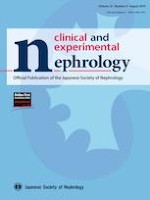Erschienen in:

15.04.2019 | Original article
Mutation analyses by next-generation sequencing and multiplex ligation-dependent probe amplification in Japanese autosomal dominant polycystic kidney disease patients
verfasst von:
Toshio Mochizuki, Atsuko Teraoka, Hiroyuki Akagawa, Shiho Makabe, Taro Akihisa, Masayo Sato, Hiroshi Kataoka, Michihiro Mitobe, Toru Furukawa, Ken Tsuchiya, Kosaku Nitta
Erschienen in:
Clinical and Experimental Nephrology
|
Ausgabe 8/2019
Einloggen, um Zugang zu erhalten
Abstract
Background
Autosomal dominant polycystic kidney disease (ADPKD), one of the most common hereditary kidney diseases, causes gradual growth of cysts in the kidneys, leading to renal failure. Owing to the advanced technology of next-generation sequencing (NGS), genetic analyses of the causative genes PKD1 and PKD2 have been improved.
Methods
We performed genetic analyses of 111 Japanese ADPKD patients using hybridization-based NGS and long-range (LR)-PCR-based NGS. Additionally, genetic analyses in exon 1 of PKD1 using Sanger sequencing because of an extremely low coverage of NGS and those using multiplex ligation-dependent probe amplification (MLPA) were performed.
Results
The detection rate using NGS for 111 patients was 86.5%. One mutation in exon 1 of PKD1 and five deletions detected by MLPA were identified. When combined, the total detection rate was 91.9%.
Conclusion
Although NGS is useful, we propose the addition of Sanger sequencing for exon 1 of PKD1 and MLPA as indispensable for identifying mutations not detected by NGS.











